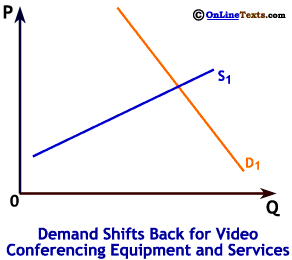

While there are very low-cost consumer-level video conferencing systems available, most businesses do not find these systems acceptable. For the purposes of this article, video conferencing equipment and services refers to high-end, professional systems that require high-speed internet connections and expensive equipment. In the short run, the demand curve for video conferencing equipment and services has shifted out, or increased, as shown to the right. We show a very large shift, from D1 to D2, for clarity. This has the effect of increasing the quantity of video conferencing equipment and services demanded from Q1 to Q2, and raising the price from P1 to P2. We show the price increasing only modestly, because prior to September 11 a lot of unused video conferencing capability seems to have been available.1
This is a very simple analysis based on a change in demand behavior, in this case a shift out of the demand curve. We could explain the increase by thinking of video conferencing as a substitute for air travel. In a sense air travel has become more expensive since September 11. Waits at airports are much longer due to increased security, and people simply feel less safe flying. Both of these can be thought of as an increase in costs. Increased time spent at airports is a very direct cost as highly paid employees wait in airports unable to be productive.
The interesting question is, what happens in the long run? Do businesses continue to rely more on video conferencing, leading to a long run increase in the demand for video conferencing equipment and services and a decrease in the demand for business flights? Or, in a few weeks or months, do things go back to where they were before September 11, causing the demand for video conferencing to return to roughly where it was prior to September 11?

Unless there are more terrorists attacks on the U.S., it seems quite plausible that this increase in demand for video conferencing will be short-lived. If so, demand might well shift back over the next few months to roughly what it was before September 11. We show this in a graph to the right. Demand shifts back and prices and quantities return to roughly where they were prior to September 11.
Another possibility is that the short-term interest in video conferencing for business meetings will cause businesses to become more comfortable with this technology, as well as allowing it to be considered a more acceptable way to hold business meetings. As more companies add video conferencing capabilities, network effects2 will aid the adoption of video conferencing as a viable alternative to face-to-face meetings. If so, the demand for video conferencing could stay high even if there are no further terrorists attacks, and even if airport waits decrease and people become more comfortable flying again. If so, we can expect an increase in the supply of video conferencing equipment and service providers over the long run as increased demand drives up prices and increases profits for companies that provide video conferencing equipment and services.

To the right we show the supply curve shifting from S1 to S2 due to the increased profitability of production of video conferencing equipment and provision of video conferencing services. We show the price of video conferencing equipment and services falling in the long run below the initial price. This may not be the case, but it seems likely that the production of video conferencing services and equipment will exhibit increasing returns to scale3 causing prices to fall in the long run.
If video conferencing becomes a very popular way of doing business in the long run, the effects will be felt by many industries including the airline and telecommunications industries, the hotel and rental car industries, and by many others whose business is directly or indirectly affected by business travel. We won't go into these effects in any detail here except to say that a large enough shift to video conferencing will ripple throughout an economy where constant travel for face-to-face business meetings has been the norm for many years.
1 In other words, the short run supply curve is fairly elastic due to the excess capacity that existed prior to September 11.